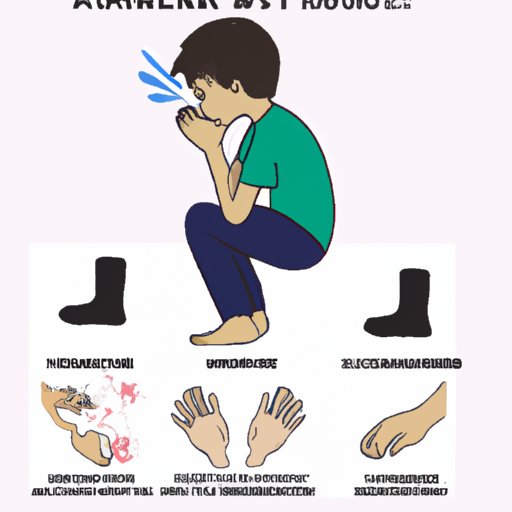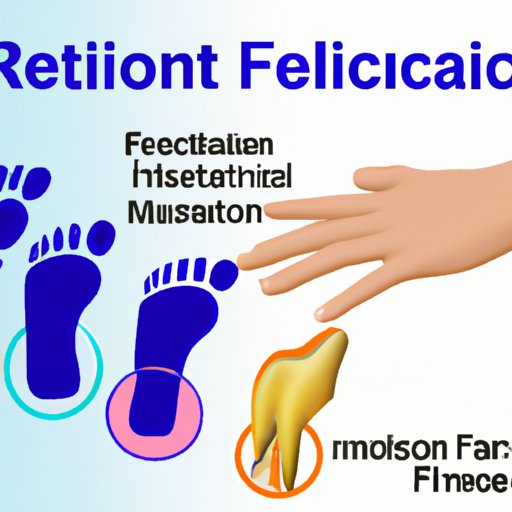
Introduction
Hand, foot and mouth disease is a common viral illness that affects children, but can also affect adults. It’s a highly contagious disease that spreads easily through poor hygiene and close contact with an infected person. This article aims to provide an in-depth understanding of the disease and to answer the question: how soon can you get hand foot and mouth again?
Overview of Hand Foot and Mouth Disease
Hand, foot and mouth disease is a viral illness usually caused by Coxsackie virus A16 and Enterovirus 71. Symptoms of the disease include fever, sore throat, and a rash on the hands, feet, and mouth. The disease can affect people of all ages, but children under the age of 5 are more susceptible.
The disease typically lasts one to two weeks, and the symptoms usually subside on their own. There is no specific treatment for hand, foot and mouth disease, but over-the-counter pain relievers and fever reducers can help to alleviate symptoms.
Understanding the Transmission of Hand Foot and Mouth Disease
Hand, foot and mouth disease spreads through contact with an infected person’s secretions, such as saliva, mucus, and fluid in blisters. It can also spread through contact with contaminated surfaces or objects.
One can contract the virus by coming in contact with an infected person, such as hugging, kissing, or sharing utensils or personal items with them.
The Immune System Response to Hand Foot and Mouth Disease
The immune system plays a vital role in fighting off the virus, and typically individuals develop immunity to the disease after being infected once. This means that once an individual contracts hand, foot and mouth disease, their immune system develops antibodies to fight off the virus in the future.
Immunity to the virus can last for a few months to several years, depending on the individual.
Reinfection of Hand Foot and Mouth: How Common Is It?
It is possible to get hand, foot and mouth disease more than once, but it is not very common. According to the Centers for Disease Control and Prevention (CDC), getting infected with one type of virus that causes hand, foot and mouth disease does not protect against other types of viruses that cause the disease.
However, reinfection rates are low because of the development of immunity after the initial infection.

Factors That Affect Reinfection of Hand Foot and Mouth
Young children and babies are more susceptible to getting infected multiple times because their immune systems are not fully developed or because they have not yet developed immunity to the virus.
Individuals with weakened immune systems or those with pre-existing medical conditions are also more likely to get reinfected.
How to Prevent Reinfection of Hand Foot and Mouth
Hand, foot and mouth disease is highly contagious and can easily be spread from person to person. There are several preventive measures individuals can take to avoid getting infected:
- Wash hands regularly with soap and water for at least 20 seconds
- Clean and disinfect frequently touched surfaces and objects
- Avoid close contact with infected individuals
- Dispose of used tissues in a covered bin and wash hands immediately
Parents and caregivers should take additional preventive measures to avoid the spread of the disease. Children should avoid close contact with others and be kept home from school or daycare until the rash has disappeared.
What to Do If You or Your Child Get Hand Foot and Mouth More Than Once
If you or your child are infected with hand, foot and mouth disease more than once, there are several steps you can take to ensure a speedy recovery:
- Stay home from school or work
- Get plenty of rest to help the immune system fight off the virus
- Drink plenty of fluids to prevent dehydration
- Take over-the-counter pain relievers or fever reducers to alleviate symptoms
- Avoid spicy or acidic foods as they may irritate the mouth sores
It’s important to seek medical attention if symptoms persist or if there are any concerns regarding the infection.
Conclusion
Hand, foot and mouth disease is a common viral illness that primarily affects children but can affect adults. It spreads easily through close contact with an infected person or through contact with contaminated surfaces. It is highly unlikely to get infected with the same virus again, but it is possible, especially in children with underdeveloped immune systems. Preventive measures such as regular handwashing and disinfecting frequently touched surfaces and objects can reduce the risk of infection.
It is essential to take care of oneself during the infection period and get plenty of rest and fluids. Anyone with symptoms that persist or have any concerns about the infection should seek medical attention.




